
The “ENGINE” Framework: Transforming Developers into Engineers
In coffee shops and Zoom calls across the tech world, the terms “Software Developer” and “Software Engineer” often get tossed around as if they’re identical. However, any seasoned tech professional who has weathered multiple system failures at 2 AM can attest that there’s a world of difference.
Our team learned this lesson early on. After shipping a feature that “worked perfectly” in a local environment, we encountered a late-night crisis when the production environment crashed. That painful experience taught us that writing functional code is only a small piece of the engineering puzzle.
The truth is that a developer focuses primarily on writing code that works, while an engineer thinks holistically about the entire system—its architecture, scalability, maintainability, and long-term health. It’s the difference between building a sandcastle and designing a skyscraper.
To help bridge this gap, our company introduced the ENGINE Framework—a structured approach that encourages systematic thinking, problem-solving, and ownership of software systems. Our goal is to help developers transition into true engineers who own their systems end-to-end.
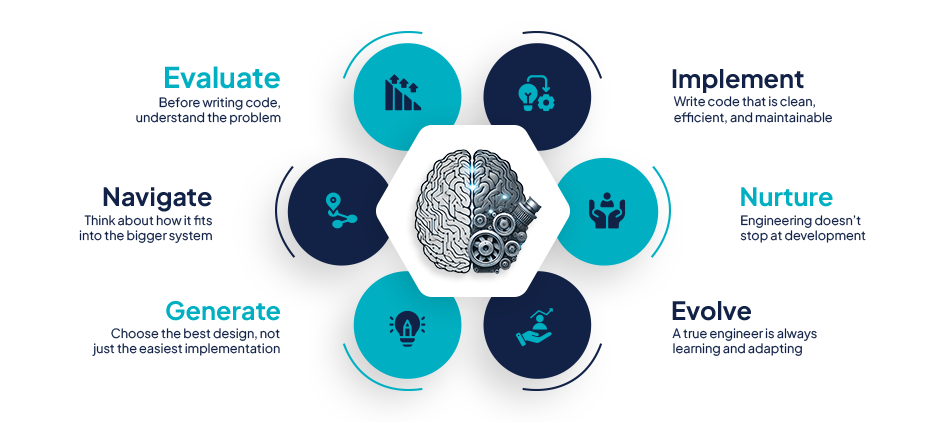
The ENGINE Framework: Think Like an Engineer
The ENGINE Framework is built on six essential pillars:
Evaluate → Navigate → Generate → Implement → Nurture → Evolve
Each step is designed with concrete actions and best practices that help shift our approach from simple code production to comprehensive system engineering. Let’s explore each component in detail.
Evaluate the Problem (E)
“Before writing code, understand the problem.”
 Understand the Why
Understand the Why
Before diving into a solution, our first step is to fully grasp why the feature or fix is needed. This means questioning the root cause of the requirement rather than accepting the ticket at face value.
- Ask stakeholders or clients about the underlying business or user pain points.
- Confirm whether the issue is symptomatic of a larger problem that needs attention.
- Define what success looks like from a user’s perspective, ensuring the solution delivers genuine value.
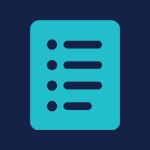 Clarify the Problem Statement
Clarify the Problem Statement
Transform vague feature requests into clear, well-defined problem statements that align with our strategic objectives.
- Write down a detailed description of the issue, including its impact on operations and user experience.
- Identify constraints such as time, budget, security, and performance that may affect the solution.
- Use techniques like the 5 Whys to peel back layers and find the core problem.
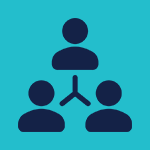 Engage with Stakeholders
Engage with Stakeholders
It is critical to involve those who are directly affected by the problem early in the process.
- Schedule discussions with users, product managers, or support teams to gather diverse insights.
- Validate assumptions about the problem with real-world feedback.
- Ensure alignment between technical solutions and business objectives.
Tools: Root Cause Analysis, 5 Whys, User Interviews, Value Stream Mapping
Navigate the Architecture (N)
“Think about how it fits into the bigger system.”
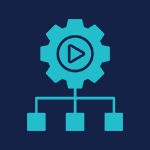 Assess System Interdependencies
Assess System Interdependencies
Evaluate where the new feature or fix will sit within our existing system architecture.
- Map out current services and how they interact, identifying potential points of integration or conflict.
- Analyze potential side effects or dependencies that may affect other parts of the system.
- Consider how data flows between components and whether this change may introduce tighter coupling than necessary.
 Plan for Resilience and Scalability
Plan for Resilience and Scalability
Look beyond immediate needs to ensure that the design can accommodate future growth and unexpected failures.
- Consider failure scenarios and create contingency plans or fallback procedures.
- Balance load distribution by potentially decoupling services, thereby reducing the impact of isolated failures.
- Anticipate future enhancements and choose designs that provide flexibility for scaling.
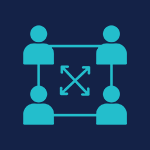 Engage Cross-Functional Teams
Engage Cross-Functional Teams
A feature’s design should be validated by those who manage adjacent systems.
- Collaborate with other teams to review integration points and ensure consistency across the system.
- Share architectural diagrams and get feedback from both development and operations teams.
- Use collaborative workshops or architecture review sessions to uncover potential blind spots early.
Tools: System Context Diagrams, C4 Model, Event Storming, Architecture Decision Records (ADRs)
Generate the Best Solution (G)
“Choose the best design, not just the easiest implementation.”
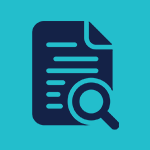 Research Multiple Approaches
Research Multiple Approaches
Encourage brainstorming and exploration of several design alternatives before settling on a solution.
- Host team sessions to discuss different algorithms or design patterns suitable for the problem.
- Document at least three possible solutions, outlining the pros and cons of each.
- Emphasize innovation and long-term benefits over quick fixes.
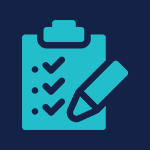 Evaluate Performance and Complexity
Evaluate Performance and Complexity
Consider the computational efficiency and maintainability of each proposed solution.
- Perform a comparative analysis of time and space complexities of different approaches.
- Factor in the expected load and usage scenarios to anticipate how the solution will behave under stress.
- Evaluate code simplicity against performance gains; sometimes a slight increase in complexity is justified by a significant performance boost.
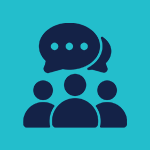 Foster Open Discussion and Consensus
Foster Open Discussion and Consensus
Ensure that the final design decision is made transparently and inclusively.
- Use decision matrices to quantify trade-offs between options.
- Engage team members in discussions about long-term maintenance implications and potential technical debt.
- Document the decision process to create a reference that supports future architectural decisions.
Tools: Design Patterns, Algorithm Analysis, Proofs of Concept (POCs), Architecture Review Sessions
Implement with Precision (I)
“Write code that is clean, efficient, and maintainable.”
 Embrace Test-Driven Development (TDD)
Embrace Test-Driven Development (TDD)
Using TDD ensures that our solutions are robust and well-thought-out from the outset.
- Write automated tests before developing the actual functionality, which clarifies the intended behavior of the code.
- Continually update tests as features evolve to cover edge cases and unexpected scenarios.
- Leverage continuous integration pipelines to run these tests automatically with every code commit.
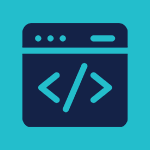 Maintain Code Quality and Consistency
Maintain Code Quality and Consistency
Consistent coding standards and code reviews are central to our implementation process.
- Use automated linting tools and formatting scripts to ensure code adheres to our established conventions.
- Conduct regular peer reviews that not only check for functionality but also assess readability, simplicity, and future maintainability.
- Invest in training sessions to keep the entire team up-to-date on best coding practices and emerging patterns.
 Improve Error Handling and Documentation
Improve Error Handling and Documentation
Thoughtful documentation and rigorous error handling make the code more understandable and easier to debug.
- Write comprehensive documentation that explains why certain design decisions were made, not just how the code functions.
- Implement meaningful error messages and logging to facilitate rapid troubleshooting and system monitoring.
- Maintain an internal knowledge base where lessons learned and architectural decisions are shared with the team.
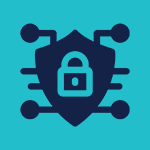 Integrate Monitoring and Security Early
Integrate Monitoring and Security Early
Security considerations and system monitoring should be integrated into the development process, not added as an afterthought.
- Incorporate security scanning tools into the CI/CD pipeline to catch vulnerabilities early.
- Set up alerts and dashboards to monitor system health, performance, and potential intrusions.
- Provide training on secure coding practices, ensuring that every line of code is designed with potential risks in mind.
Tools: Test-Driven Development, Code Reviews, Static Analysis, Security Scanning, CI/CD Pipelines
Nurture the System (N)
“Engineering doesn’t stop at deployment—it includes continuous monitoring and maintenance.”
 Monitor System Performance Actively
Monitor System Performance Actively
Once deployed, it is crucial to continuously assess how the system performs under real-world conditions.
- Set up comprehensive dashboards that track key performance indicators (KPIs) such as response times, error rates, and resource utilization.
- Implement proactive alert systems to notify the team of anomalies or performance degradations.
- Schedule regular reviews of system logs to detect unusual patterns that may signal emerging issues.
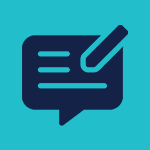 Collect and Act on User Feedback
Collect and Act on User Feedback
User feedback is a critical resource for ongoing improvement.
- Develop channels—such as surveys, user interviews, or support ticket analysis—to gather direct feedback from users.
- Systematically review feedback to identify common issues or trends that may require immediate attention.
- Use insights gained from users to prioritize system improvements and refinements.
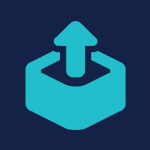 Plan for Regular Maintenance and Upgrades
Plan for Regular Maintenance and Upgrades
Building resilient systems means being prepared for ongoing maintenance and iterative enhancements.
- Establish periodic maintenance windows where the team can perform routine system checks, updates, and optimizations.
- Create a clear operational playbook that outlines steps for incident response, ensuring quick and coordinated actions when problems arise.
- Invest in training and resource allocation to manage technical debt and ensure that older code segments remain robust and secure.
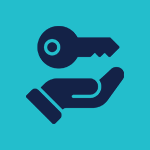 Promote a Culture of Ownership and Accountability
Promote a Culture of Ownership and Accountability
Encourage teams to take full responsibility for their code, from development through production support.
- Adopt a “you build it, you run it” approach, where the same team that develops a feature also handles its operation.
- Celebrate successes and learn from failures by conducting thorough post-mortems and sharing outcomes with the organization.
- Ensure that every team member understands their role in maintaining long-term system quality.
Tools: Monitoring Tools (Prometheus, Grafana), Log Analysis (ELK Stack), User Feedback Systems, Chaos Engineering
Evolve Continuously (E)
“A true engineer is always learning and adapting.”
 Commit to Ongoing Learning
Commit to Ongoing Learning
In a rapidly changing technological landscape, continuous education is essential.
- Allocate time and resources for technical training, certifications, and attending industry conferences.
- Encourage participation in internal tech talks, learning circles, and cross-team mentoring programs.
- Foster an environment where experimentation is valued and learning from both successes and failures is encouraged.
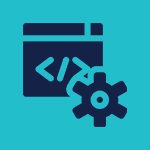 Regularly Reassess and Refactor
Regularly Reassess and Refactor
View every piece of code and every system as a living entity that benefits from periodic re-evaluation.
- Schedule regular technical debt clean-ups to refactor code, improve performance, and simplify designs.
- Use retrospectives after major projects or incidents to identify what worked well and what needs improvement.
- Continuously update documentation and design patterns to reflect current best practices and organizational learning.
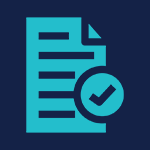 Adapt to Changing Requirements
Adapt to Changing Requirements
Stay proactive in anticipating shifts in technology and market demands.
- Keep track of emerging trends and new technologies that could be integrated to improve our systems.
- Regularly engage with stakeholders to reassess whether the current system design meets evolving user needs.
- Apply iterative improvements that keep the system modern, secure, and efficient without disrupting ongoing operations.
 Encourage a Growth Mindset
Encourage a Growth Mindset
Emphasize the importance of viewing challenges as opportunities to grow and innovate.
- Celebrate instances where refactoring or deletion of outdated code has improved system performance.
- Recognize and reward team efforts that contribute to long-term improvements, rather than just short-term fixes.
- Promote open discussions about failures and learnings, creating a supportive environment for continuous personal and professional growth.
Tools: Retrospectives, Learning Circles, Technical Book Clubs, Conference Participation, Internal Tech Talks
Why the ENGINE Framework Works for Us

- Structured Growth Beyond Technical Skills:
By following a disciplined approach to evaluate, design, implement, and maintain systems, our teams move beyond basic coding and develop a comprehensive engineering mindset that addresses both immediate and long-term needs.
- Balancing Short-Term and Long-Term Goals:
The framework supports balancing rapid feature delivery with the long-term stability and scalability of our systems. We avoid the “fix it later” trap by proactively addressing issues before they snowball into technical debt.
- Fostering a Culture of Ownership:
Encouraging full lifecycle management and continuous monitoring nurtures a sense of accountability and pride. When teams truly “own” their projects, they invest more in both immediate quality and future enhancements.
- Enhancing Collaboration and Transparency:
Cross-functional review sessions and open discussions about design trade-offs help build trust and ensure that multiple perspectives contribute to creating robust solutions.
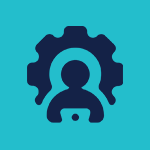 Practical Implementation: A 30-Day Plan
Practical Implementation: A 30-Day Plan
Start small and gradually integrate each step of the ENGINE Framework into daily routines. Here’s an actionable 30-day plan:
Week 1: Evaluate
- Action: Before starting any coding work, team members document their understanding of the problem.
- Detail: Schedule a kick-off meeting where each feature is broken down into a detailed problem statement. Facilitate discussions to align on desired outcomes and constraints.
- Outcome: A shared, clear problem statement that guides the design process.
Week 2: Navigate
- Action: Create a system architecture diagram for every new feature or change.
- Detail: Use whiteboard sessions or digital diagramming tools to map out where the new component fits into the existing system, including dependencies and potential points of failure.
- Outcome: A visual representation that aids in understanding and validating the design in context.
Week 3: Generate
- Action: Brainstorm and compare multiple solutions for each problem.
- Detail: Organize brainstorming sessions where team members present at least two different approaches. Use decision matrices to compare factors such as performance, maintainability, and implementation effort.
- Outcome: A consensus-driven choice for the most balanced and effective solution.
Week 4: Implement with Precision
- Action: Integrate testing, documentation, and monitoring into the coding process from day one.
- Detail: Begin coding by writing tests first and setting up automated tools for linting and security. Ensure that every module includes clear comments and error handling protocols.
- Outcome: A robust, production-ready solution that meets quality standards and is easily maintainable.
Beyond 30 Days: Integrate Nurture and Evolve
- Action: Once initial implementation is in place, focus on monitoring and iterative improvements.
- Detail: Set up dashboards, schedule maintenance windows, review user feedback, and plan periodic refactoring sessions. Establish recurring internal sessions to share lessons learned and keep skills current.
- Outcome: A living system that evolves to meet changing requirements, fostering continuous improvement and innovation.
Conclusion
Shifting from developers to engineers within our organization is not about changing job titles—it’s about evolving our mindset and operational practices. The ENGINE Framework guides us in broadening our focus from merely writing code to architecting robust, scalable systems that deliver lasting value.
By embracing each element—from evaluating the problem thoroughly to nurturing and evolving our systems—we ensure that every solution is designed for both today’s challenges and tomorrow’s growth. This approach not only elevates the quality of our work but also strengthens our commitment to creating systems that truly serve our users and business objectives.
For additional insights or to discuss how to integrate the ENGINE Framework into your projects, please reach out to our engineering leadership team. Together, we build not just code, but resilient, future-proof solutions.
FAQs – The ENGINE Framework
- What is the ENGINE Framework?
The ENGINE Framework is a structured approach that helps developers transition into engineers by focusing on six key steps: Evaluate, Navigate, Generate, Implement, Nurture, and Evolve. It encourages a systematic mindset, ensuring developers think beyond just writing code and take full ownership of software systems.
- How is a software engineer different from a developer?
A developer primarily focuses on writing functional code, whereas a software engineer considers the entire system, including architecture, scalability, maintainability, and long-term sustainability. Engineers take a broader, problem-solving approach to ensure that software not only works but remains efficient and adaptable over time.
- Why is problem evaluation important?
Evaluating the problem before coding ensures that the right issue is being solved rather than just addressing symptoms of a larger issue. This step helps prevent unnecessary rework, reduces technical debt, and leads to more effective and user-centric solutions.
- How does architecture navigation help?
Navigating system architecture allows engineers to ensure that new features integrate seamlessly into existing systems without introducing bottlenecks or dependencies that could cause long-term issues. This practice leads to better scalability, improved performance, and more resilient software systems.
- What is the best way to generate solutions?
The best approach is to brainstorm multiple possible solutions, analyze their trade-offs, and select the one that balances performance, maintainability, and efficiency. Engineers should prioritize solutions that optimize system performance while keeping long-term scalability in mind.
How Can Datavision help?
We assist various financial institutions and global banks on their digital transformation journey. Our one-of-a-kind approach, which combines people, process, and technology, expedites the delivery of superior results to our clients and drives excellence. Several reputed companies leverage our proprietary suite of business excellence tools and services to unlock new growth levers and unparalleled ROI.
Datavision stands proudly as a prominent banking software solutions provider, recognized for our unwavering commitment to excellence in the industry. We have earned our esteemed reputation by consistently delivering cutting-edge core banking software, catering to the needs of both retail and corporate banking software sectors. At Datavision, our mission is clear: to provide our clients with the best banking software products, ensuring that they stay ahead in an ever-evolving financial landscape. We take pride in serving our prestigious clients and look forward to continuing our journey of innovation and excellence.
Our portfolio of banking software product and services include:
Core Banking Solutions: | FinNext Core | Banking: | FinTrade | EasyLoan | MicroFin |
Digital Banking Solutions: | IBanc | MobiBanc | MBranch | FinTab | FinSight |
Payments: | FinPay |
Risk & Compliance: |FinTrust |
Want to know how our team of experts at Datavision provides customizable, scalable, and cost-effective banking software products and solutions to our esteemed clients? Visit us for more information.


 Understand the Why
Understand the Why Clarify the Problem Statement
Clarify the Problem Statement Engage with Stakeholders
Engage with Stakeholders Assess System Interdependencies
Assess System Interdependencies Plan for Resilience and Scalability
Plan for Resilience and Scalability Engage Cross-Functional Teams
Engage Cross-Functional Teams Research Multiple Approaches
Research Multiple Approaches Evaluate Performance and Complexity
Evaluate Performance and Complexity Foster Open Discussion and Consensus
Foster Open Discussion and Consensus Embrace Test-Driven Development (TDD)
Embrace Test-Driven Development (TDD) Maintain Code Quality and Consistency
Maintain Code Quality and Consistency Improve Error Handling and Documentation
Improve Error Handling and Documentation Integrate Monitoring and Security Early
Integrate Monitoring and Security Early Monitor System Performance Actively
Monitor System Performance Actively Collect and Act on User Feedback
Collect and Act on User Feedback Plan for Regular Maintenance and Upgrades
Plan for Regular Maintenance and Upgrades Promote a Culture of Ownership and Accountability
Promote a Culture of Ownership and Accountability Commit to Ongoing Learning
Commit to Ongoing Learning Regularly Reassess and Refactor
Regularly Reassess and Refactor Adapt to Changing Requirements
Adapt to Changing Requirements Encourage a Growth Mindset
Encourage a Growth Mindset
 Practical Implementation: A 30-Day Plan
Practical Implementation: A 30-Day Plan